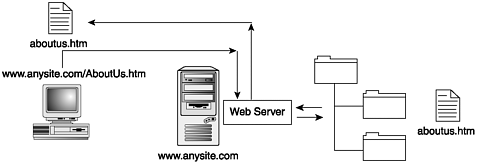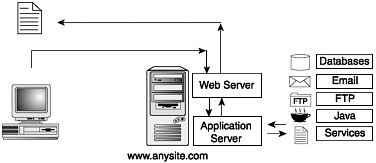| If you are reading this book, you are probably already familiar with the basic concept of web publishing. World Wide Web documents are created in Hypertext Markup Language (HTML) using various tools ranging from text editors like Notepad and Macromedia Homesite to what-you-see-is-what-you-get (WYSIWYG) programs, such as Macromedia Dreamweaver or Microsoft FrontPage. These documents are then placed on a web server and can be requested and viewed with a browser. As previously mentioned, information can be published to the web following a static or dynamic model. These models will be explained in the following two sections. Static Publishing Static web publishing is a rather straightforward process. A web server is created by installing web server software on a computer. There are many makers of web server software, but the two leaders are Apache Web Server and Microsoft Internet Information Server (see the Netcraft Web Server Survey at www.netcraft.com). Files that make up a web site are then stored on the server in much the same way that files are stored on your PC. A client can request to see one of those files by using a browser and URL, such as www.anysite.com/aboutus.htm. The server then finds the requested file in its directory structure and sends a copy back to the client that requested it. This model is presented in Figure 1.1. Figure 1.1. Static web publishing.  The web server does not process the file in any way other than to serve a copy to the client. If you were to view the source code of the file using your browser's View, Source command, you would see exactly the same code that is stored on the server. These static pages can be made a bit more exciting by adding client-side JavaScript, but the JavaScript commands are served to the client in the same way as the HTML code. The client's web browser and computer process the JavaScript code, not the web server. Dynamic Publishing Moving to a dynamic publishing model enables you to make your web site more powerful, responsive, and flexible. In many cases, moving to dynamic publishing involves adding additional software to the web server. This additional software is called application server software. ColdFusion Server is an example of an application server. Other examples include Macromedia JRun, IBM WebSphere, and Sun's iPlanet. An application server is capable of interacting with the web server and other network services to dynamically generate web pages on-the-fly, depending on things like available data or user preference. The dynamic web publishing process is shown in Figure 1.2. Figure 1.2. Dynamic web publishing.  Dynamic publishing gives you the opportunity to take advantage of many additional services and features like the following: Querying and manipulating databases. (For example, listing all products from a certain category.) Performing conditional processing on data. (For example, if a user does not enter a password, you can send him back to the login page with a message that says he must enter a password.) Web site security. (For example, password protecting private areas of your site.) Personalizing content. (For example, tracking user preferences and prior site visits.) Building search engines and shopping carts. Interacting with other Internet services, such as email. Creating mailing lists and user surveys. Interacting with other technologies, such as SOAP, Java, and Macromedia Flash.
In addition to adding these powerful components, dynamic publishing also eases the burden of web site administration by enabling you to easily reuse code and centralize content. |